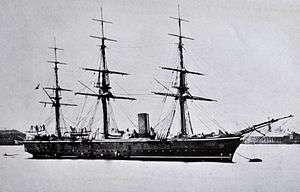Emerald-class corvette
The Emerald-class corvettes were a class of six composite screw corvettes built for the Royal Navy in the mid-1870s. The Opal was built by contract under the 1873-74 Programme, and Turquoise, Ruby, Tourmaline and Emerald under the 1874-75 Programme - the first three also by contract, while Emerald was dockyard-built at Pembroke. The final ship (Garnet) was also dockyard-built at Chatham under the 1875-76 Programme.
 Turquoise at anchor | |
| Class overview | |
|---|---|
| Name: | Emerald class |
| Operators: |
|
| Preceded by: | HMS Rover |
| Succeeded by: | Bacchante class |
| Built: | 1873–1878 |
| Completed: | 6 |
| Scrapped: | 6 |
| General characteristics (as built) | |
| Type: | Composite screw corvette |
| Tonnage: | 1,864 bm |
| Displacement: | 2,120 long tons (2,150 t) |
| Length: | 220 ft (67.1 m) (p/p) |
| Beam: | 40 ft (12.2 m) |
| Draught: | 18 ft (5.5 m) |
| Installed power: | 2,031–2,364 ihp (1,515–1,763 kW) |
| Propulsion: |
|
| Sail plan: | Ship rig |
| Speed: | 12–13 knots (22–24 km/h; 14–15 mph) |
| Range: | 2,000–2,280 nmi (3,700–4,220 km; 2,300–2,620 mi) at 10 knots (19 km/h; 12 mph) |
| Complement: | 230 |
| Armament: |
|
Design and construction
The construction used iron frames, with wooden cladding around the frames. These were two-decked ships, with the ordnance on the upper deck and accommodation on the main deck below. They were designed to carry the same armament of fourteen 64-pdr guns as the preceding Amethyst class corvettes from which their design was developed, with two of the guns mounted on rotating slides as bow and stern chasers, and the other twelve guns slide-mounted on the broadsides.
However, only Opal was so completed, and two of her broadside guns were removed following her first commission. Tourmaline was built with the same number of ports, but with only ten broadside guns vice twelve (plus the two chase guns). The other four vessels were completed with this ordnance (two chasers and ten broadside guns, without ports for a sixth pair of broadside guns) - all these guns being of the 64cwt model. In the early 1880s Tourmaline and Emerald were re-armed with four 6-inch (100-pdr) and eight 5-inch (50-pdr) breach-loader guns.
Ships
| Ship | Builder[1] | Laid down[2] | Launched[2] | Completed[2] | Fate[2] | Cost[2] |
|---|---|---|---|---|---|---|
| Opal | William Doxford, Sunderland | 13 October 1873 | 9 March 1875 | January 1876 | Sold for scrap, 11 August 1892 | £95,949 |
| Turquoise | Earle's Shipbuilding, Hull | 8 July 1874 | 22 April 1876 | 13 September 1876 | Sold for scrap, 24 September 1892 | £95,547 |
| Ruby | Earle's Shipbuilding, Hull | 8 July 1874 | 9 August 1876 | 14 June 1877 | Converted to coal hulk, December 1904; sold for scrap, 16 February 1921 | £93,116 |
| Tourmaline | Raylton Dixon, Middlesbrough | 17 July 1874 | 30 October 1875 | January 1874 | Converted to coal hulk, 1899; sold for scrap, November 1920 | £95,769 |
| Emerald | Pembroke Dockyard | 29 July 1874 | 18 August 1876 | 2 July 1878 | Converted to powder hulk, 1898; sold for scrap, 10 July 1906 | £98,442 |
| Garnet | Chatham Dockyard | 16 March 1875 | 30 June 1877 | 31 October 1878 | Sold for scrap, December 1904 | £92,468 |
Notes
Footnotes
- Chesneau & Kolesnik, p. 51
- Lyon & Winfield, p. 289
Bibliography
- Ballard, G. A. (1937). "British Corvettes of 1875: The Six Composite Corvettes". Mariner's Mirror. Cambridge, UK: Society for Nautical Research. 23 (April): 176–89.
- Chesneau, Roger; Kolesnik, Eugene M., eds. (1979). Conway's All the World's Fighting Ships 1860–1905. Greenwich, UK: Conway Maritime Press. ISBN 0-8317-0302-4.
- Winfield, R.; Lyon, D. (2004). The Sail and Steam Navy List: All the Ships of the Royal Navy 1815–1889. London: Chatham Publishing. ISBN 978-1-86176-032-6.
| Wikimedia Commons has media related to Emerald class corvette. |